Face Mites: Causes, Diagnosis, Treatment, & Home Remedies
Combining home remedies and medicated creams can solve this issue effectively.
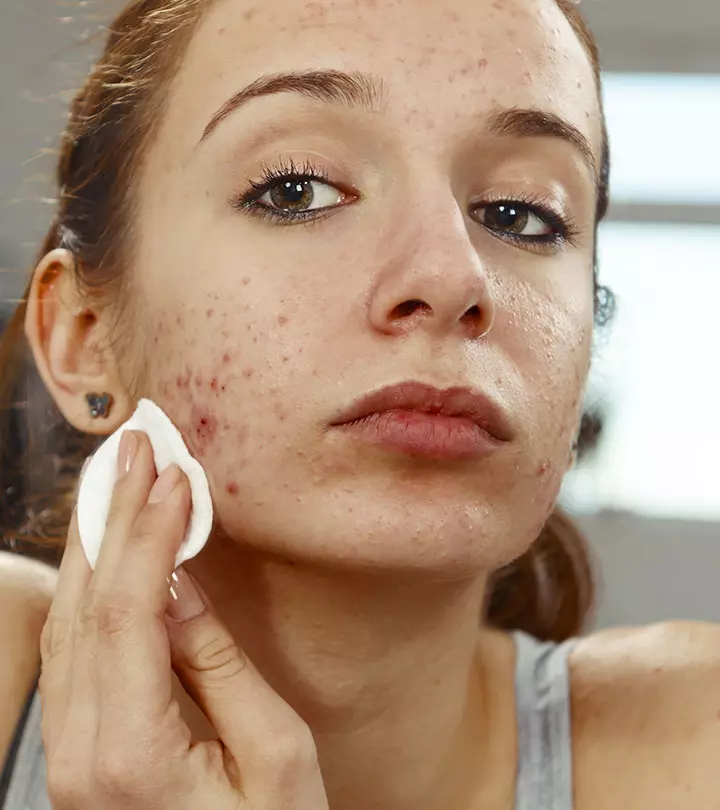
Image: iStock
Face mites are eight-legged microscopic parasites that survive on the skin and skin oils.
They breed and produce offspring on the skin. These parasites are mostly (not totally) harmless and don’t show any symptoms.
Face mite infestation is higher in males in comparison to females. This article explains all about face mites and other related issues. Read on to know more.
In This Article
Face Mite Or Demodex Mite: What Is It?
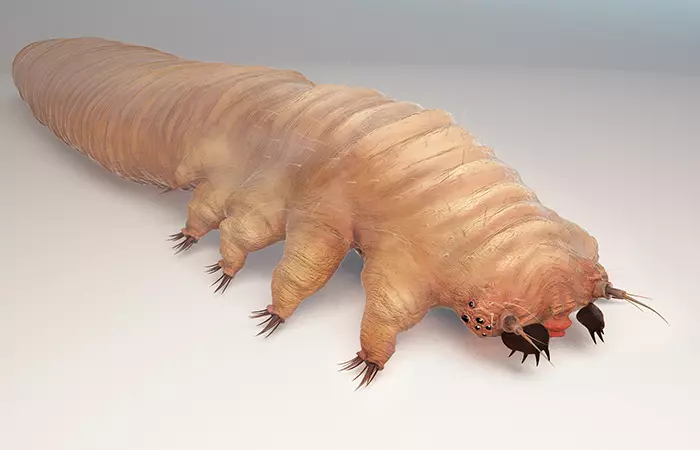
Face mites or Demodex mites are obligate ectoparasites (parasites living outside the host’s skin that cannot complete their life cycle without a host) found on human skin. Demodex infestation is prevalent in humans.
In any healthy adult, the infestation of Demodex is between 23 to 100%. These skin mites stay on your skin without showing any symptoms. However, an imbalance in the number of these mites can cause certain skin issues (1).
There are about 65 species of Demodex, but only two of those are found on the human skin. These are:
- Demodex folliculorum (D. folliculorum): These are found in the hair follicles and on the face. They feed on dead skin cells and sebum. An excess of D. folliculorum on your skin can increase skin cells in your hair follicles, making your skin appear rough and scaly.
- Demodex brevis (D. brevis): Unlike D. folliculorum, D. brevis are not limited to the face alone. These mites are more commonly found on the neck and chest and have a wider distribution on your body. They get deeper into your sebaceous glands and ducts and feed on your gland cells.
These mites were first identified in 1841-42. Infestation of D. folliuculorum is more common in humans. These infestations increase with age.
Face mite infestation is the highest in individuals aged between 20 and 30 years. This can be attributed to the increased sebum secretion. Compared to females (13%), face mite infestation is much higher in males (23%) (1).
These mites can get transferred between hosts through physical contact (via nose, hair, eyebrows, etc.). They are mostly harmless and do not cause any symptoms. The microorganism is a part of the human microbiome and maintains a symbiotic association with the skin(2). However, several external and/or internal factors (such as hereditary defects in T-cells and the immune system) may cause colonization of face mites, leading to certain skin conditions.
Key Takeaways
- Face mites may stay on the skin without showing any symptoms unless there is an imbalance in their population, which may cause certain skin issues.
- Skin sensitivity, redness, eczema, and rough textured skin are a few common signs of face mite colonization.
- Excessive sebum production can encourage face mites to proliferate, so treatment usually involves the use of products to cleanse the skin of excess oils and buildup.
Face Mites: Causes, Symptoms, And Complications
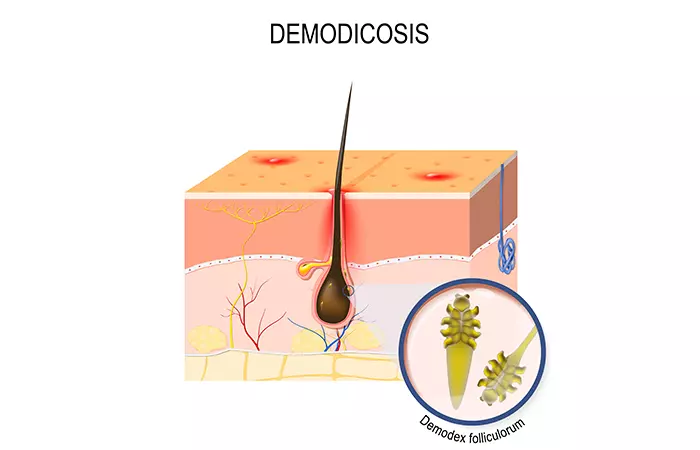
You cannot get rid of face mites. They are always present on your skin. However, if they increase in number, they might cause several complications. Here are the symptoms of both types of face mites.
D. folliculorum
If your skin is infested with D. folliculorum, it will turn rough and scaly. D. folliculorum increases the number of skin cells in your hair follicles. Other symptoms of this infestation include:
- Skin redness
- Itchy skin
- Burning sensation
- Eczema
- Rough texture
- Skin sensitivity
These symptoms are common. Several factors can increase the risk of D. folliculorum infestation:
- Alopeciai An autoimmune disorder that attacks hair follicles and causes hair loss from the scalp or other areas of the body.
- Weak immune system
- Dermatitisi A long-term allergic, inflammatory skin condition that causes itchy, red, swollen, and cracked skin.
- Skin infections
- Rosaceai A common long-term inflammatory skin condition that causes flushing and visible blood vessels on the face. (loss of eyelashes)
Researchers are still investigating the relationship between D. folliculorum infestation and several other skin conditions. Some studies could establish a possible connection between D. folliculorum and rosaceai A common long-term inflammatory skin condition that causes flushing and visible blood vessels on the face. . The skin condition could be a risk factor for Demodex infestation in the eyelashes (3).
D. brevis
If your skin is infested with D. brevis, it can appear red with rough patches. The most common symptoms of D. brevis infestation are:
- Burning sensation on the skin
- Redness
- Roughness
- Itchiness
- Rashes
- Changes in skin color
- Scaliness
Several factors can aggravate your risk of developing D. brevis infestation. These are:
- Rosaceai A common long-term inflammatory skin condition that causes flushing and visible blood vessels on the face.
- Oily skin
- Eczema
- Acne
- Weak immune system
- Hair loss
Detecting face mites or Demodex is not quite easy. Most of us do not know of these parasites until they trigger symptoms, and we get our skin tested.
Diagnosing And Treating Face Mites
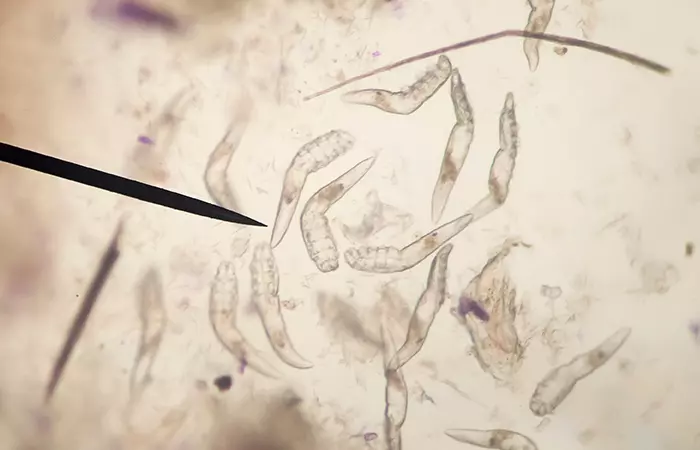
Skin biopsy can help diagnose the presence of face mites or Demodex. Doctors perform cyanoacrylic adhesion along with a biopsy to find out the density of face mites on your skin surface (1). They take a sample from your skin and examine it under the microscope.
This biopsy is needed if you are experiencing serious complications caused by severe infestation of face mites. Your doctor may suggest the following medications that can help minimize the infestation.
Medical Treatments For Face Mites
Keeping your skin clean is the first step to minimize face mite infestation (as they feast on your sebum and dead cells). You may also be prescribed the following medications:
- Salicylic acid
- Ivermectin
- Benzyl benzoate
- Crotamiton
- Permethrin
- Selenium sulfide
- Sulfur
- Metronidazole
The doctor might suggest topical or oral medication, depending on the severity of your infestation. If an underlying dermatology condition triggers the infestation (such as rosaceai A common long-term inflammatory skin condition that causes flushing and visible blood vessels on the face. and eczema), you will need a separate treatment.
If the infestation is mild, you can treat it using simple home remedies.
Home Remedies For Face Mites
1. Tea Tree Oil

A study tested several ingredients on Demodex. Tea tree oil was found to be the most potent remedy for killing face mites, thanks to the presence of terpinen-4-ol (4).
Kate, a blogger, shared her experience of how tea tree oil temporarily stopped the itching caused by demodex mites. She said, “For several hours I didn’t experience any itching on my scalp or body but as the night fell, I started to feel like things were moving on my skin (ⅰ)”
How To Use
- Mix two to three drops of tea tree oil with any carrier oil and massage on your face.
- Leave it on for 30 minutes and then wash with plain water.
- Repeat two to three times a week.
The same study found that dill weed and caraway oils also help kill face mites. You may use these oils instead of tea tree oil.
 Quick Tip
Quick Tip2. Alcohol
A study found that 100% alcohol could kill face mites in just about 43.9 minutes
(5). However, be careful while using 100% alcohol on your skin as it might cause skin irritation and contact dermatitisi A long-term allergic, inflammatory skin condition that causes itchy, red, swollen, and cracked skin. . Consult a doctor before using alcohol on your skin.
3. Neem
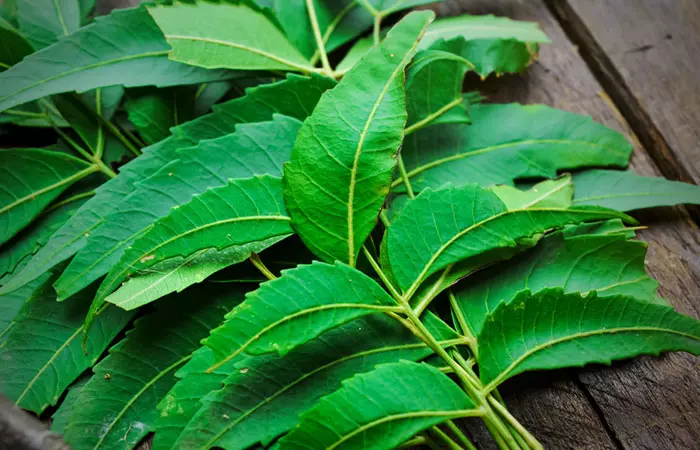
Research is limited here. However, it was found that neem could kill two other variants of Demodex found in dogs (6). You can give it a try and see if it works for you.
How To Use
- Boil neem leaves in water for a few minutes.
- Strain the water and store the decoction in a spray bottle.
- Spritz it on your face occasionally.
- You may also massage neem oil (mixed with any other oil) on your face.
4. Apple Cider Vinegar
Apple cider vinegar, a versatile natural remedy, can be an effective solution for combating face mites. Anecdotal evidence suggests that apple cider vinegar may help control face mites and alleviate associated skin problems.
How to Use
- Mix equal parts apple cider vinegar and water to create a solution.
- Apply the diluted mixture to the affected areas of your face using a cotton ball.
- Leave it on, allowing it to air-dry for 15-20 minutes, before rinsing it off with lukewarm water.
- Repeat this process 2-3 times a week for optimal results.
Remember to perform a patch test first. If any irritation occurs, discontinue its use.
Apart from these remedies, taking care of your skin and keeping it clean minimizes infestation. Follow these steps every day:
- As you wash your face and bathe daily, also wash your hair and keep your scalp clean.
- Use a non-soap and mild cleanser to clean your face. Focus on the eyelashes and eyebrows.
- Exfoliate your skin regularly to remove the dead skin cells and other impurities.
- Avoid using creams, gels, or lotions that make your skin oily.
 Quick Tip
Quick TipFace mites have a short life span of just two weeks. They don’t poop as they do not have anuses (thankfully). However, they explode and die, spreading all the waste on your skin.
They thrive in the greasiest parts of your skin, usually nestled inside your pores. When you are asleep, they crawl out to mate and then go back again into the pores to lay eggs.
When their population is in control, these mites help in removing (or eating) the dead skin cells from your skin. You can only control their excess growth.
Note: If you notice symptoms like constant redness, and intense itching, or your skin isn’t improving with home treatments, it’s best to see a dermatologist. Also, seek medical advice if the irritation worsens, spreads, or leads to noticeable skin damage. A doctor can provide stronger treatments or diagnose any underlying issues that might be causing the problem.
While home remedies can help manage face mites, prevention is key to keeping them at bay. Discover essential strategies to prevent future outbreaks below!
Prevention Strategies For Face Mites
Here are some simple strategies to help keep your skin healthy and prevent issues:
- Clean your face regularly to remove excess oil and debris.
- Avoid sharing personal items like makeup brushes, towels, or facecloths with others.
- Sanitize skin care tools, makeup brushes, and sponges frequently.
- Use lightweight, non-comedogenic moisturizers that keep your skin hydrated without clogging pores.
- Wash bedding and pillowcases often to keep them free of oil and bacteria.
Infographic: Lifecycle Of Face Mites
Face mites are naturally present on various body parts, including the face and scalp. As long as their populations are checked, they do not cause issues and can benefit skin health. Check the infographic below to learn about their typical lifecycle so that you can be aware of these inhabitants. Illustration: StyleCraze Design Team
We understand that everything about the face mites may make you cringe and you didn’t had any idea that these mites are always crawling on your skin, causing ocassional troubles. However, now that you are aware of the fact, it is best to maintain proper skin hygiene and keep it clean. It is because while these microscopic mites may not create any trouble, there is always a chance of Demodex infestation, which may lead to scaliness, rashes, rough texture, and changes in skin color. Therefore, it is best to notice the changes on your skin and consult a dermatologist to address any underlying condition you may have.
Frequently Asked Questions
Can you feel mites crawling on your skin?
No, the mites are too small for you to feel them crawling on your skin.
Are face mites harmful?
No, face mites are not harmful in small numbers. However, if there are a large number of face mites, they can cause skin issues.
Can I see face mites with the naked eye?
No, the mites are extremely small in size and are approximately 0.1 to 0.4 mm in length, which makes them invisible to the naked eye.
Do face mites prefer certain areas of the face?
Yes, since face mites survive on skin oil, they are commonly found on the nose, cheeks, and mouth. They are even found around the eyes due to the high sebum production in these areas.
Illustration: Face Mites: Causes, Diagnosis, Treatment, & Home Remedies

Image: Stable Diffusion/StyleCraze Design Team
Are you aware that tiny mites are living on your face right now? Find out more in this video about these microscopic creatures! Watch now!
Personal Experience: Source
StyleCraze's articles are interwoven with authentic personal narratives that provide depth and resonance to our content. Below are the sources of the personal accounts referenced in this article.
(i) Let’s exterminate!
https://botherthisrosacea.blogspot.com/2014/12/lets-exterminate.html
References
Articles on StyleCraze are backed by verified information from peer-reviewed and academic research papers, reputed organizations, research institutions, and medical associations to ensure accuracy and relevance. Read our editorial policy to learn more.
- “Human Demodex Mite: The Versatile Mite of Dermatological Importance” Indian Journal of Dermatology, US National Library of Medicine.
National Institutes of Health - The skin microbiome
https://www.ncbi.nlm.nih.gov/pmc/articles/PMC3535073/ - “Demodex and rosacea: Is there a relationship?” Indian Journal of Ophthalmology, US National Library of Medicine National Institutes of Health.
https://www.ncbi.nlm.nih.gov/pmc/articles/PMC5778578/ - “Terpinen-4-ol is the Most Active Ingredient of Tea Tree Oil to Kill Demodex Mites” ARVO Journals.
https://tvst.arvojournals.org/article.aspx?articleid=2110345 - “In vitro and in vivo killing of ocular Demodex by tea tree oil” British Journal of Ophthalmology, US National Library of Medicine National Institutes of Health.
https://www.ncbi.nlm.nih.gov/pmc/articles/PMC1772908/ - “Morphological characterization of demodex mites and its therapeutic management with neem leaves in canine demodicosis” Journal of Entomology and Zoology Studies.
https://www.entomoljournal.com/archives/2017/vol5issue5/PartI/5-4-135-212.pdf
Read full bio of Dr. Sreekar Harinatha
Read full bio of Ramona Sinha
Read full bio of Anjali Sayee
Read full bio of Shiboli Chakraborti






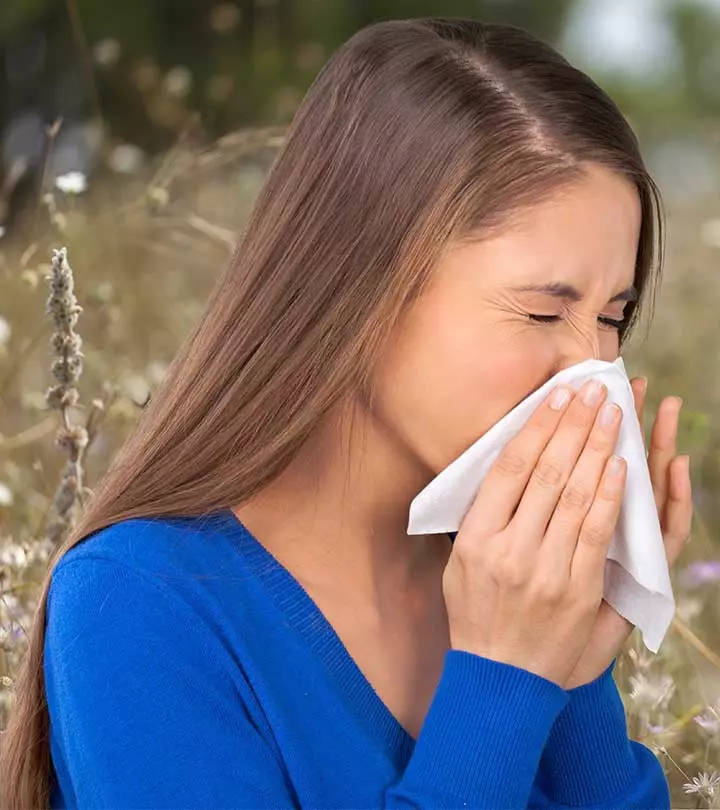





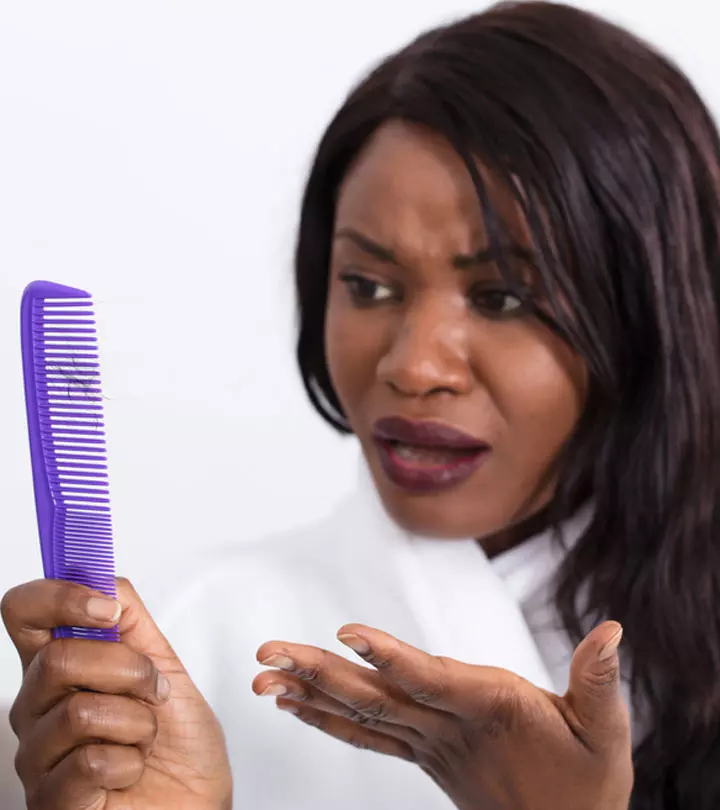

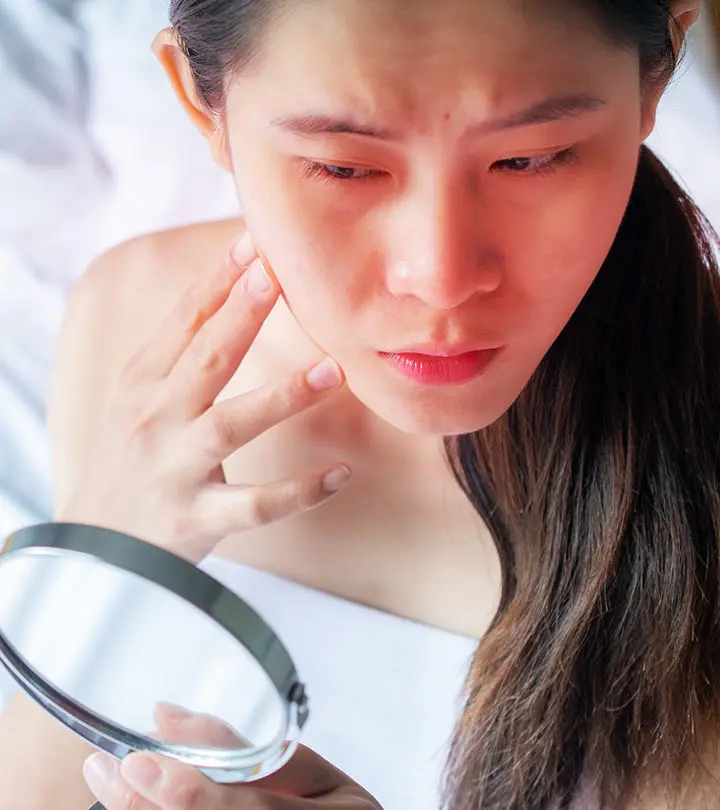



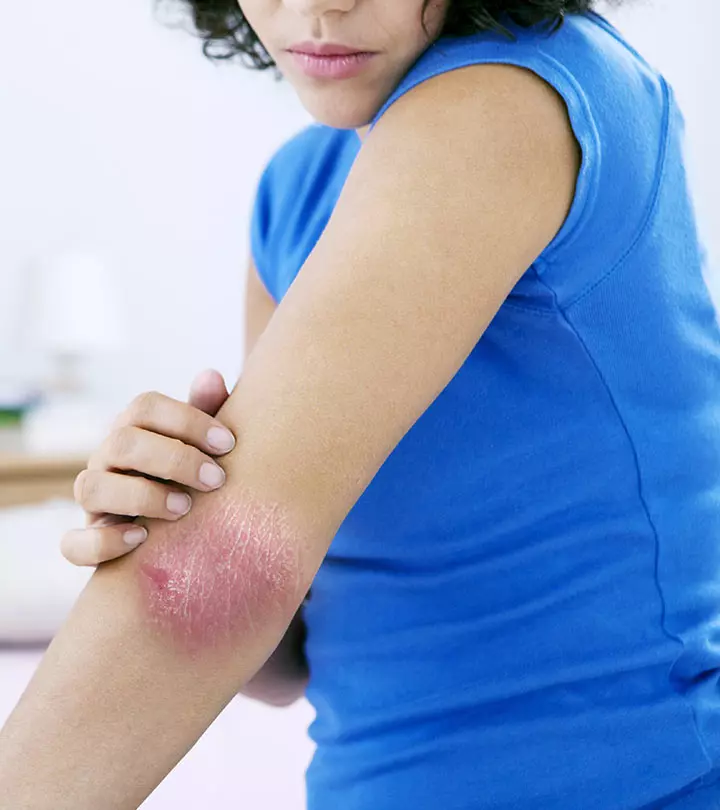



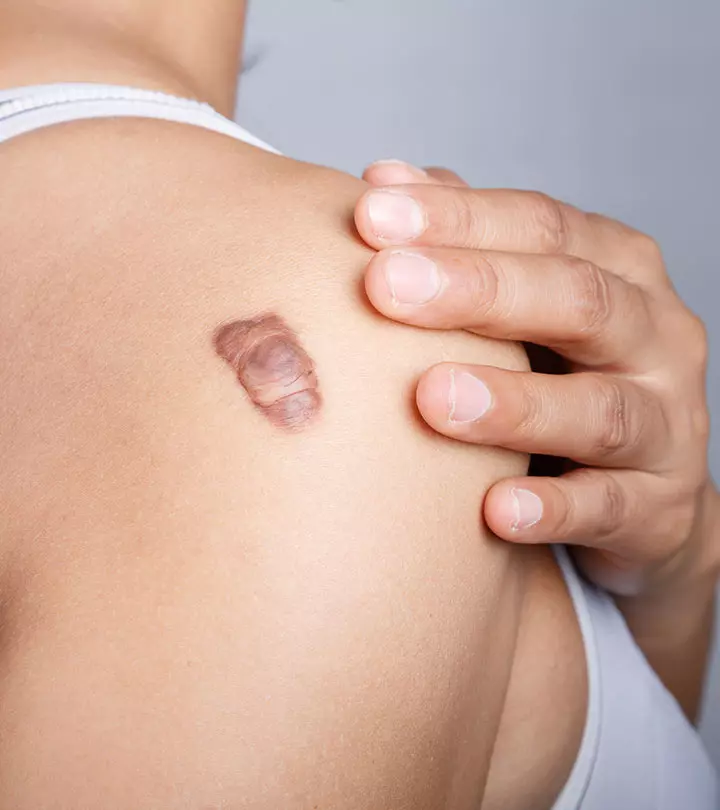


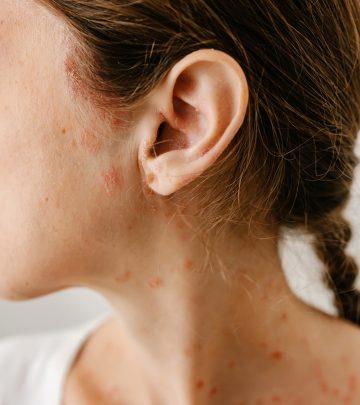

Community Experiences
Join the conversation and become a part of our empowering community! Share your stories, experiences, and insights to connect with other beauty, lifestyle, and health enthusiasts.